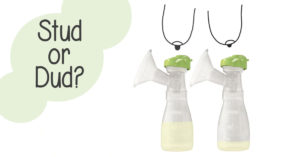
One of These Breasts Is Not Like the Other
By: Jennifer Pitkin, BS, IBCLC of Ardo USA
Are you a member of the Wonky Boob Club? Do you have a Stud and a Dud? Do you ever pump both sides and silently yell at one side, “WHY aren’t you pulling your weight?!”
You’re not alone. The good news is that you can still successfully pump or breastfeed if one breast produces more milk than the other!
Lots of moms are members of the ‘one side of the bra doesn’t fit all club’. I’m actually the president. Today I retired a nursing bra, because super boob was jumping the gun all over the top of my left bra cup. The other side, as the norm, enjoyed it’s gappy, underachiever space.
Does this sound like you? That’s great! Welcome to the club!
I’m a nursing/pumping mom, and a Lactation Consultant. After nursing and pumping for three kiddos and studying all things breast-related, I can tell you that in most cases, this is a totally manageable and normal thing. However, I know that it can absolutely be disconcerting, especially when your little one fusses at the breast. They’re smart little creatures. They quickly learn which side offers more milk and will nurse with little resistance there.
In general, the old saying totally applies here, “If it ain’t broke, don’t fix it”. If baby wants to nurse on the more productive side first and comforts on the other side, that’s totally fine. If the amount of milk you pump from slacker boob falls within the range of your ounce goal, that’s also totally fine!
When things get frustrating, for you or babe, here are a few tips:
-
Offer the lesser producing side first. Your little one might not dig this during waking hours, so try this when they’re a bit sleepy. To ease frustration at the slower flow, consider adding some compression at breast to speed things up and aid in milk removal.
-
When nursing on the higher production side, try hand expression or pumping on the other side. It doesn’t take much to tweak your supply. A few minutes a few times/day is usually a manageable goal.
-
Add a few minutes a few times a day of single pumping within 30 minutes after a nursing session on the lesser producing side. Add massage while pumping.
-
Consider bodywork. Yup, bodywork. It’s “that thing” that people don’t quite understand, that little research has been done on, and that often offers GREAT results. I’ve observed bodywork in our clinical breastfeeding practice and in my training with babies with shallow latches, tight gapes, tongue mobility restriction, and/or torticollis. The moms and babies that I refer out for bodywork thrive. My two go-to’s for bodywork (and I choose providers to recommend carefully) are Craniosacral Therapy, also called CST, and Chiropractic care. In-utero, infants aren’t always optimally positioned. Muscular and skeletal tension frequently shows when feeding. A slight tightness on one side of the neck, for example, can lead to a preference for one side, discomfort for mom and/or babe as the infant seeks more comfortable positioning, and better milk transfer on the side baby nurses better on. Bodywork can often alleviate these symptoms.
More about bodywork:
According to Monica Basille, PhD, CPM, LMT, CD(DONA), CCE(BWI), RMT of Seva Center for the Healing Arts, “Craniosacral Therapy is an extremely gentle, non-invasive, and effective form of bodywork. Infant CST can be a tremendous help for mothers and babies experiencing milk supply issues. A CST practitioner will assess for patterns of tension or torsion that can affect the baby’s ability to coordinate suck and swallow, or to effectively use the tongue and jaw to transfer milk. Once a baby has full and optimal function in the neck, jaw, and tongue, s/he can better stimulate the breasts to increase milk production.”
More about Chiropractic Care:
On a personal note, my third baby, now seven months old, and I had challenges nursing from the get-go. My nipples were sore and cracked. One side was considerably more painful when nursing, and production there was (and still is) about 75% less than the other side. Before we sought chiropractic care, my infant also screamed in his carseat continuously. After meeting with our chiropractor, we found that he had slight torticollis, likely from lying transverse in-utero. After having him adjusted, he stopped screaming in his carseat and began nursing better on both sides!
A friend, colleague, fellow nursing mom, and chiropractor at Hawk Nation Chiropractic had this to say regarding chiropractic care benefitting a nursing relationship, “Chiropractic care allows the nervous system, which controls everything in the body, to function at full potential. If the spinal column is misaligned it may cause a decrease in nerve flow. If the brain is not able to communicate with the rest of the body, there is a decrease in function somewhere in the body. If a baby has a subluxation (misalignment) in their upper neck, it can affect the baby’s sucking pattern and ability to latch onto the breast. As well as decrease the range of motion and muscle tension in their neck and prevent them from latching onto one or both sides of the mother’s breast. This can cause major problems in the breastfeeding relationship.”
Uneven breastfeeding breasts are really the norm. Run over to Facebook and see how many times this pops up in local breastfeeding support group threads. It’s a pretty much everyday occurrence that a question similar to, “One of my breasts is producing WAY more. How do I fix it?” As my business partner, Kimberly Hendricks, and I say, “It’s not a problem unless it’s a problem.” This means, if you and babe are bonding well and baby is thriving, celebrate being in the club. When it is a problem, talk to your local International Board Certified Lactation Consultant, also called an IBCLC or LC. They’ll point you in the right direction.
We don’t have t-shirts celebrating our memberships to the Wonky Boob Club, because no one has yet manufactured one for uneven boobs. The slightly padded nursing bra club, might soon be our thing!
